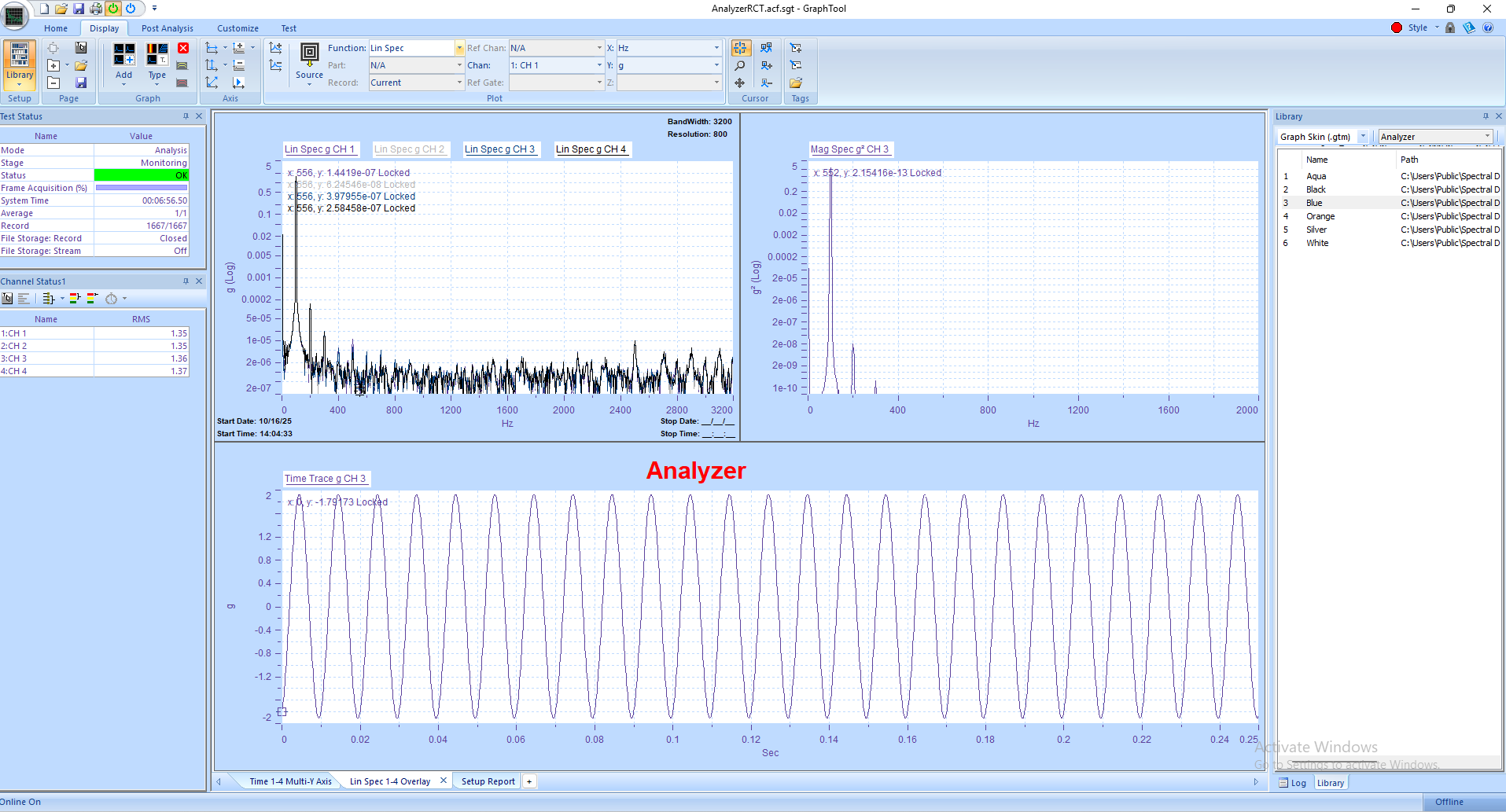Analyzer
Panther Analyzer extends the power of Spectral Dynamics' next-generation Panther platform with advanced tools for vibration and modal analysis. Integrated directly into Panther's unified environment, Analyzer combines precision data acquisition, adaptive signal processing, and real-time display capability within the same intuitive interface used for all control applications.
Built on the proven foundation of Spectral Dynamics' over eighty years of vibration test experience, Analyzer is designed for engineers who demand trusted, repeatable results—from structural modal characterization and transient capture to detailed spectral and sine analysis. The application leverages Panther's exceptional 24-bit ADC resolution and >110 dB dynamic range to deliver measurement fidelity that meets the most demanding test requirements.

Key Capabilities
• FFT, 1/n Octave, and Statistical Analysis: Comprehensive time- and frequency-domain insight with configurable resolution, windowing functions, and averaging methods for precise spectral characterization.
• Modal Data Acquisition and Analysis: Configurable degree-of-freedom (DOF) selection with support for multiple DOF sets, reference channel assignment, and seamless integration with modal analysis workflows.
• Sine Analysis: Evaluating harmonic response and system linearity with swept sine capability, accurate frequency tracking, and transfer function measurement.
• Transient Capture and Analysis: Shock, impact, and non-stationary event capture with trigger controls, pre-trigger buffering, and offline shock response spectrum (SRS) analysis from stream files.
• Fully Functional Signal Generator: Excitation and calibration tasks supporting multiple waveform types including sine, sine chirp, random, pseudo-random, user-defined waveforms, burst, and DC. Precise frequency/amplitude control with adjustable taper and delay functions.
• Multi-Stream Acquisition: Synchronized sampling across all channels with support for multiple independent data streams at different sample rates—a unique capability for capturing both high-frequency and low-frequency phenomena simultaneously.
• Adaptive Filtering and Custom Process Lines: Dynamic signal interpretation with user-defined process lines for monitoring, alarming, and real-time data conditioning.
• Gap-Free Streaming to Disk: Complete traceability of every test event with continuous data recording to host disk, ensuring no data loss during acquisition.
Software Integration & Ease of Use
Panther Analyzer shares the same modern, intuitive interface as all Panther applications, operated through Spectral Dynamics' GTX software environment. GTX provides a unified platform for test setup, execution, analysis, and report generation.
• The Library feature enables instant access to test setups, stored data files, and previous runs—eliminating the need to search Windows directories. Users can assign aliases or common names to files and mark favorites for even quicker access.
• Easily and quickly compare live test data with historical measurements across different channels and test runs, enabling rapid validation and troubleshooting.
• The entire user interface is fully compatible with touch-screen operation, including Microsoft Surface and other Windows PCs, ensuring flexible control in any laboratory environment.
• Export capabilities include Microsoft Word, PDF, Excel, and various image formats with customizable report generation and automated print functions.
• Advanced visualization tools including waterfall plots, composite displays, Bode plots, and time traces provide comprehensive insight into system behavior.
Applications
• Modal and Structural Dynamics Testing
• Transient and Shock Analysis
• Sine and Harmonic Response Characterization
• Transfer Function Measurement
• Aerospace and Automotive Qualification Testing
• R&D Vibration Analysis and Correlation
• Product Development and Validation
• Environmental Stress Screening
Technical Data Sheet
|
Input Subsystem |
Output Subsystem |
|
Input Channels: 8 Channels Expandable up to 32 |
DAC: 20 Bit |
|
Dynamic Range: >110dB |
Max Output Amplitude: ±12 Volts Peak |
|
ADC: 24 Bit |
Max Output Current: 16 mA |
|
Amplitude Accuracy: ±0.20% of value or ±0.03% of full scale |
Amplitude Linearity: ±0.20% of value or ±0.03% of full scale |
|
Voltage Ranges: ±12V to ±0.5V in 8 steps (Auto Ranging) |
Max Output Rate: 262,144 Samples per Second |
|
Overload Detection: Full scale on all channels, analog and digital detection |
Image Attenuation: <96dB |
|
Voltage Coupling: AC or DC or GND |
Frequency Accuracy: ±5 ppm |
|
IEPE Power: 4 mA (24V max into open circuit) |
Freq Range Reduction: 10 stage smoothing filters |
|
Max Rated Input Signal: ±35 Volts Peak |
Reconstruction Filters: Analog 1kHz–25kHz, >96dB attenuation, ±0.15dB ripple |
|
Max Sampling Rate: 262,144 Samples per Second |
Output Impedance: 60 Ohms |
|
Input Impedance: 1 MΩ |
Output Type: Pseudo-Differential, 10Ω to Ground |
|
Connection Type: Pseudo-Differential |
Output Cable: Drives up to 50 feet of shielded 50Ω coax |
|
Calibration: Automatic Internal Digital Calibration (NIST referenced) |
Calibration: Internal Digital Calibration (NIST referenced) |
|
TEDS Compliant: Yes |
Calibration Constants: Digital Calibration Constants stored in ASCII file |
|
Host to Unit Communication: USB / Ethernet / Optional Wi-Fi |
COLA Output Level: 1 Volt Peak (post-filter) |
|
Sampling Interval: Simultaneous on all channels |
|
|
Frequency Accuracy: ±5 ppm |
|
|
Freq. Range Reduction: Digital decimation and filtering using on-board FPGA and DSP |
|
|
Anti-Aliasing Filters: |
|
|
Analog: Fixed @ 120 KHz, >105dB, ±0.10dB ripple |
|
|
Digital: Variable, >96dB @ Nyquist, ±0.15dB ripple |
|
|
Offset Removal: Digitally Controlled, Accuracy ±0.5% of full scale for each input range |
|
|
Connector Type: BNC |
|
|
Calibration Constants: Digital Calibration Constants stored in ASCII file |
|

